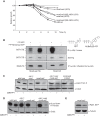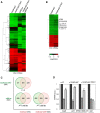Fission yeast Cdk7 controls gene expression through both its CAK and C-terminal domain kinase activities
- PMID: 25691663
- PMCID: PMC4387208
- DOI: 10.1128/MCB.00024-15
Fission yeast Cdk7 controls gene expression through both its CAK and C-terminal domain kinase activities
Abstract
Cyclin-dependent kinase (Cdk) activation and RNA polymerase II transcription are linked by the Cdk7 kinase, which phosphorylates Cdks as a trimeric Cdk-activating kinase (CAK) complex, and serine 5 within the polymerase II (Pol II) C-terminal domain (CTD) as transcription factor TFIIH-bound CAK. However, the physiological importance of integrating these processes is not understood. Besides the Cdk7 ortholog Mcs6, fission yeast possesses a second CAK, Csk1. The two enzymes have been proposed to act redundantly to activate Cdc2. Using an improved analogue-sensitive Mcs6-as kinase, we show that Csk1 is not a relevant CAK for Cdc2. Further analyses revealed that Csk1 lacks a 20-amino-acid sequence required for its budding yeast counterpart, Cak1, to bind Cdc2. Transcriptome profiling of the Mcs6-as mutant in the presence or absence of the budding yeast Cak1 kinase, in order to uncouple the CTD kinase and CAK activities of Mcs6, revealed an unanticipated role of the CAK branch in the transcriptional control of the cluster of genes implicated in ribosome biogenesis and cell growth. The analysis of a Cdc2 CAK site mutant confirmed these data. Our data show that the Cdk7 kinase modulates transcription through its well-described RNA Pol II CTD kinase activity and also through the Cdc2-activating kinase activity.
Copyright © 2015, American Society for Microbiology. All Rights Reserved.
Figures






Similar articles
-
Specificity of Cdk activation in vivo by the two Caks Mcs6 and Csk1 in fission yeast.EMBO J. 2001 Jan 15;20(1-2):82-90. doi: 10.1093/emboj/20.1.82. EMBO J. 2001. PMID: 11226158 Free PMC article.
-
Cdc2 activation in fission yeast depends on Mcs6 and Csk1, two partially redundant Cdk-activating kinases (CAKs).Curr Biol. 1999 Apr 22;9(8):441-4. doi: 10.1016/s0960-9822(99)80194-8. Curr Biol. 1999. PMID: 10226032
-
A CDK-activating kinase network is required in cell cycle control and transcription in fission yeast.Curr Biol. 2002 Jul 9;12(13):1100-5. doi: 10.1016/s0960-9822(02)00903-x. Curr Biol. 2002. PMID: 12121616
-
The cdk-activating kinase (CAK): from yeast to mammals.Cell Mol Life Sci. 1999 Feb;55(2):284-96. doi: 10.1007/s000180050290. Cell Mol Life Sci. 1999. PMID: 10188587 Free PMC article. Review.
-
CAK-Cyclin-dependent Activating Kinase: a key kinase in cell cycle control and a target for drugs?Cell Cycle. 2005 Apr;4(4):572-7. Epub 2005 Apr 16. Cell Cycle. 2005. PMID: 15876871 Review.
Cited by
-
PKC iota promotes cellular proliferation by accelerated G1/S transition via interaction with CDK7 in esophageal squamous cell carcinoma.Tumour Biol. 2016 Oct;37(10):13799-13809. doi: 10.1007/s13277-016-5193-9. Epub 2016 Aug 1. Tumour Biol. 2016. PMID: 27481515
-
Cdk7: a kinase at the core of transcription and in the crosshairs of cancer drug discovery.Transcription. 2019 Apr;10(2):47-56. doi: 10.1080/21541264.2018.1553483. Epub 2018 Dec 6. Transcription. 2019. PMID: 30488763 Free PMC article. Review.
-
Histone H2B ubiquitylation represses gametogenesis by opposing RSC-dependent chromatin remodeling at the ste11 master regulator locus.Elife. 2016 May 12;5:e13500. doi: 10.7554/eLife.13500. Elife. 2016. PMID: 27171419 Free PMC article.
-
Reciprocal regulation of TORC signaling and tRNA modifications by Elongator enforces nutrient-dependent cell fate.Sci Adv. 2019 Jun 19;5(6):eaav0184. doi: 10.1126/sciadv.aav0184. eCollection 2019 Jun. Sci Adv. 2019. PMID: 31223645 Free PMC article.
-
Dissecting the Pol II transcription cycle and derailing cancer with CDK inhibitors.Nat Chem Biol. 2020 Jul;16(7):716-724. doi: 10.1038/s41589-020-0563-4. Epub 2020 Jun 22. Nat Chem Biol. 2020. PMID: 32572259 Free PMC article. Review.
References
Publication types
MeSH terms
Substances
Grants and funding
LinkOut - more resources
Full Text Sources
Molecular Biology Databases
Research Materials
Miscellaneous
